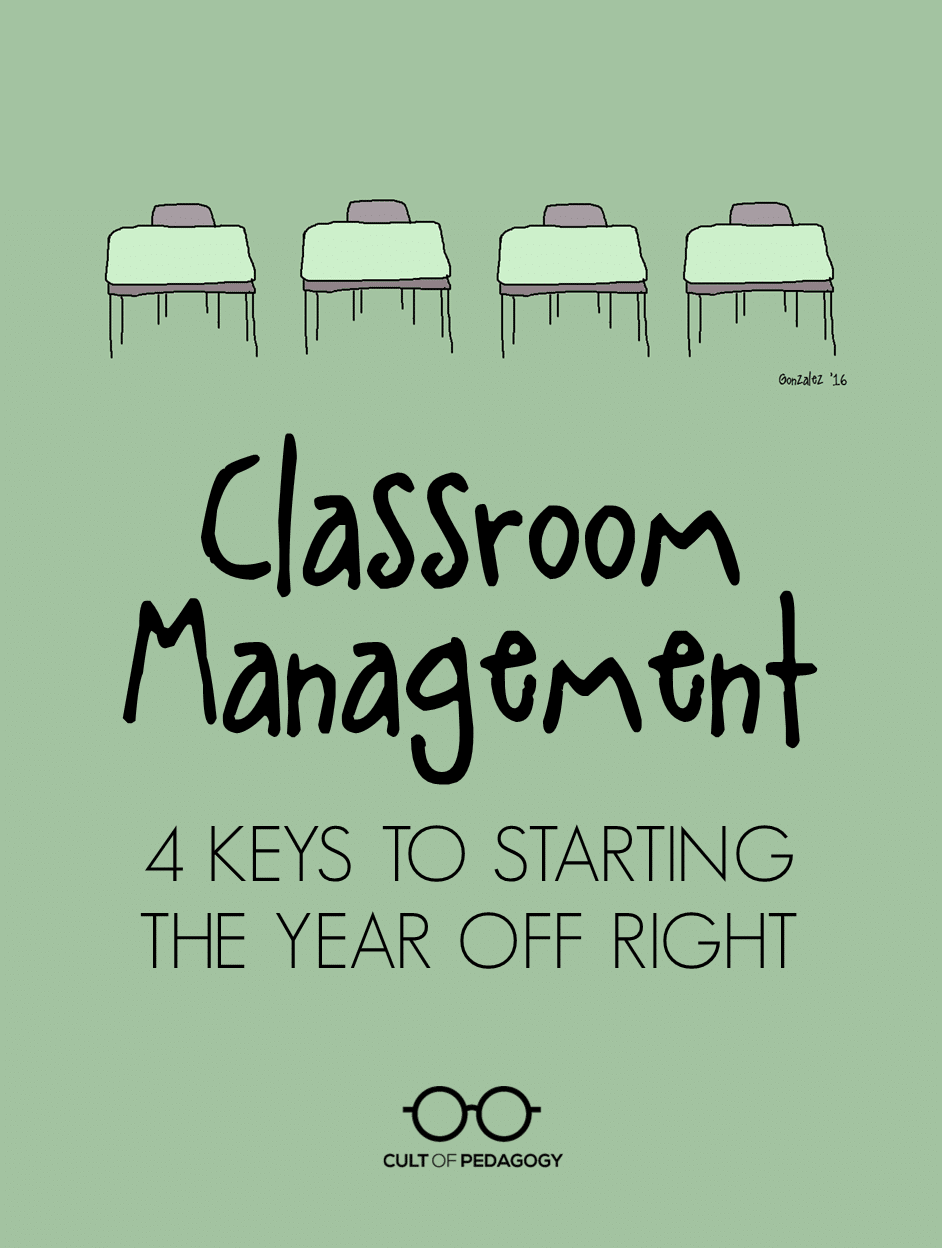
Listen to my interview with Michael Linsin here or read a full transcript.
When I was a teacher, classroom management was not my strongest suit. I relied heavily on forming good relationships with my students, thereby preventing misbehavior. This worked about 90 percent of the time; I really didn’t have a whole lot of behavior problems. Unfortunately, the way I dealt with that other 10 percent was rather haphazard: Far too often, I defaulted to the “Wait till there’s a problem, then react” mode.
If I had known about Michael Linsin back then, if I’d had access to the stockpiles of advice he shares on his website, Smart Classroom Management, I would have done things differently.
For you, though, it’s not too late. If you haven’t already discovered Michael Linsin or Smart Classroom Management, this will be a good day for you. Because a few weeks ago, Michael and I spent close to an hour talking on Skype. I asked him to share his advice for teachers implementing a classroom management plan for the school year.

Michael Linsin
For those who want the quick version, I have pulled the four most important points he made—four keys to setting up and implementing a classroom management plan so that it really works—and summarized them here.
Key 1: Have an Actual Plan
My biggest classroom management mistake was that “wait and see” mentality I mentioned before. I never really had a clear plan, and I don’t remember ever giving more than a few minutes to explaining my rules and procedures to students. Honestly, I didn’t want them to think I was mean, or boring, or lame. I wanted to talk about the good stuff on day 1, not bog students down with a bunch of negativity.
And year after year, that bit me in the butt. It’s not that I had badly behaved students, but my lack of clear structure made my job way harder than it had to be. If I’d set up and communicated a clear behavior plan at the beginning of each year, I know I would have enjoyed teaching a lot more.
A classroom management plan should not be complicated. All you need are rules and consequences.
Classroom Rules
Linsin recommends creating a short, simple list of rules. “It’s important just to think about how you can protect your students’ right to learn and also protect your freedom to teach. You want to think about all those behaviors from your experience that are interfering with those two goals, and you create a set of rules as boundaries that protect that freedom.”
In his basic classroom management plan, Linsin recommends including the following rules:
- Listen and follow directions.
- Raise your hand before speaking or leaving your seat.
- Keep your hands and feet to yourself.
- Respect your classmates and your teacher.
Now I’ll tell you this: I have always had my doubts about simple lists like this, because I felt they were way too open to interpretation (and misinterpretation). Too much gray area. But that’s because I didn’t understand how to effectively implement a simple list of rules. Now I do, and I’m going to get into that in Key 2. But first, the consequences.
Classroom Consequences
To accompany the simple list of classroom rules, Linsin recommends a short sequence of consequences for breaking the rules:
- Warning
- Time-out
- Letter home
Linsin acknowledges that these rules and consequences are pretty standard, and he does not insist that all teachers stick to his specific choices. “There is no magic in the rules and consequences themselves,” he says. “It’s how you present them and then how you fulfill them.”
That’s where the magic starts to happen.
Key 2: Teach your plan. REALLY teach it.
This is not the same as “going over” the rules. That’s just reading off a list and basically telling students what you expect. While that’s better than nothing, it isn’t enough. If you want students to really understand exactly how they should behave and exactly what will happen if they don’t, you need to teach your behavior plan as you would any other piece of content. The bulk of this, Linsin says, can be accomplished through detailed modeling of appropriate and inappropriate behaviors.
“Model those rules so there are no misunderstandings about what they mean, and what behaviors they cover. You would model from your perspective as the teacher and as a student, so you may be sitting in a student’s chair with the students surrounding you showing them precisely how to raise their hands.”
Linsin urges teachers to be excruciatingly specific in this modeling. “The more detailed you are, even to a ridiculous degree,” he says, “the more effective and powerful it is. I may show them the actual bend in the elbow of how to raise their hand, the finger placement…”
And after you model the behavior, have the students model it back for you. “You may have the whole class showing you how to raise their hand, how to get up to get a tissue. You may have one model, and then you’ll have five model, and then you’ll have them all model at the same time.”
Although this kind of detailed teaching takes time at the beginning of the year, it ultimately saves you time and frustration later. And it may not be necessary to teach ALL the rules on the very first day. “Let’s say you have time to only model one rule,” Linsin says. “If you model it in a highly detailed way, it transfers. They begin to understand that you’re going to expect that with everything. The first routine you teach of the year, you want to teach the heck out of it, to a remarkable, ridiculous level, because you’re not so much teaching the routine, you’re teaching how to do things the right way. You’re teaching excellence. You’re setting the tone of ‘This is how we do it here. We do things the right way, and we pursue excellence in everything we do.’”
Key 3: Enforce Like a Robot
When it’s time to enforce your rules and consequences, establish some professional distance between you and your students. Execute your plan without getting emotional about it. Linsin advises teachers to be “incredibly personable with the students, and build really close relationships, but when it comes to classroom management, you’re an unfeeling robot almost. Or a referee on a football field. You call them like you see them.”
For a lot of teachers, this is easier said than done. I know it was for me. When students misbehaved, I did kind of take it personally. My heart believed that if they respected me, if they cared about me, then they wouldn’t talk when I was talking, they wouldn’t fool around when they were supposed to be doing something else. It upset me, and I’m sure that showed on my face and in my voice. It added an extra layer of tension and compounded the problem, making the interaction more about the student and me than about the behavior.
It would be far more effective for teachers to train themselves to perceive misbehavior the way Linsin does.
“It’s not me,” he tells himself. “It’s a choice they’re making, and there’s a consequence for that choice. I’m not going to take it personally. I’m not going to feel like that student is doing that because of me.”
He urges teachers to treat infractions quickly and with no emotion. “I believe in never lecturing, scolding, any of that kind of stuff, because every time you do it, it just makes managing your classroom more difficult.”

Key 4: Sell Your Class
Although making sure students have razor-sharp clarity of your behavior plan is essential, it’s just as important to make students want to be in your class.
“You have to sell your program,” Linsin explains. “My number one goal is not that at the end of the day that they know the rules and consequences. It’s that they’re happy and excited to be part of the class. That they run home to their parents and say, ‘Oh my gosh. I have the best teacher. I have this awesome class. We’re going to do this and that this year. It’s going to be great.’ Because that’s what’s going to give you the leverage. The classroom management secret is to create a classroom that students love being a part of.”
So spend lots of time that first day getting students excited about the year, about the learning they’re going to do and the community they will create. “The idea of classroom management, of my website, is not just to get through the day,” Linsin says. “It’s to create an experience those students will remember for a lifetime.” ♦
Michael Linsin is the author of several books on Classroom Management: Dream Class, The Classroom Management Secret, and The Happy Teacher Habits*. His most recent publication is an e-book, The Smart Classroom Management Plan For High School Teachers.
* Some of these are affiliate links. If you make a purchase through these links, I get a small commission from Amazon at no extra cost to you.
Join the Cult of Pedagogy mailing list and get weekly tips, tools, and inspiration—in quick, bite-sized packages—all geared toward making your teaching more effective and fun. You’ll get access to my members-only library of free downloadable resources, including my e-booklet, 20 Ways to Cut Your Grading Time in Half, which has helped thousands of teachers spend less time grading. If you are already a subscriber and want this resource, just check your most recent email for a link to the Members-Only Library—it’s in there!





Great tips that I really appreciate . While reading , I felt myself being described. Hats off
Hi. I am the mother of a very bright boy who has addhd . Does Michael have any tips for teachers that help them better deal with the addhd child?
Thanks again Jennifer for a wonderfully helpful list of classroom management skills. This will always be my challenge area, however I feel better equipped having read Michael’s tips. Love your site x
Jennifer – As always…quality stuff here! After reading “Pushout” and listening to that podcast, I’m curious to know Michael’s thoughts on collaborating with students to create these class rules. Would that be as effective?
Thanks for the great interview! Right after I listened I purchased the high school e book, since I teach 7th grade. Would you agree that is the direction I should go in? Thanks !
Listened to the podcast this morning while on a walk and was blown away by all of the practical details and suggestions! Last year was my first year teaching so I’m hoping to make this year even better and you’ve both helped so much! Also appreciated the high school perspective. Thank you!!
I cannot thank you enough for introducing me to Michael Linsin and his ideas on classroom management. This is definitely where I need the most help as a teacher! I am encouraged and inspired. Thank you!
Ahh I love Michael Linsins stuff. I wish he had a podcast because I love listening on my drive to work! Thank you for this interview 🙂 my first year teaching, I read dream
Class, tabbed all the sections and frequently return back to it. So good. And I need reminders! I will admit that I had already planned a token economy system for individual, team, and class. So hard to break that habit.
Thanks!
I love the letter home idea, as it engages parents and conveys the message that you want the best for their child and want to build relationships with them as well. Also, it is the third step, not a lot of time wasted on nonsense. Can you share a template for this or give out some suggestions/ ideas? Thank you.
He is my favorite. His web site and advice are the reason I didn’t quit teaching during a hard second year. Now I am starting my fifth. His weekly emails/blog posts are specific, helpful, and uplifting. He is basically my hero. Loved his Happy Teacher Habits book. He has addressed SO MANY topics on his site. If you have questions about specifics, search them up on his site. Odds are he’s covered it.
What a great article. Lots of helpful ideas! Thanks for sharing.
The rules governing the schoolroom should, so far as possible, represent the voice of the school. Every principle involved in them should be so placed before the student that he may be convinced of its justice. Thus he will feel a responsibility to see that the rules which he himself has helped to frame are obeyed.
Rules should be few and well considered; and when once made, they should be enforced. Whatever it is found impossible to change, the mind learns to recognize and adapt itself to; but the possibility of indulgence induces desire, hope, and uncertainty, and the results are restlessness, irritably, and insubordination.
Thanks for sharing this information. In this era of the millennials, teachers should be innovative and flexible even to managing the classroom. It should start here right? At the beginning of the school year, create an impression that you mean business and part of that is imparting knowledge while managing smartly the classroom
Classroom management tends to be one of my strengths, and they are due the exact keys above. However, I agree 100% with you about building those relationships with students and their families. Building positive rapports is more than half the battle. Apparently, it’s 90% of the battle. I glance through the Harry Wong Book First Days of School a few times every summer just to refresh my memory. My classroom plan is improved to as close to perfection every school year. The one thing I don’t do explicitly is well my classroom. But one belief that I share in my philosophy of education is that learning should be fun. You can check it out at http://www.Renewedteacherblog.wordpress.com. Because I believe this, fun naturally happens I’m my classroom and the kids can’t get enough. Thank you for posting this and recommending Michael Linsin and his books. I plan to read Dream Classroom.
Classroom management is one of my strengths. I feel that it is because as you share in this post, building relationships is 90% of the battle. Having positive rapports with students and theit families just seems to make things easier. But you also talk about the other 10%. I agree that there has to be a plan, that has to be a specific plan that is instructed and explained, enforced, reinforced and practiced. Although I don’t feel I intenionally sell my class, in my philosophy of education, I believe that learning should be fun! You can read more about this at http://www.Renewedteacherblog.wordpress.com. Because I believe this, it’s natural for my class to be sold. It’s not always easy because there is at least one student that doesn’t buy in, but that just means that when they do buy in, you have that much more reason to celebrate. If they never do, you know you sis your best. Thanks for writing this post, and sharing Michael Linsin’s insights! I plan to read his book Dream Classroom in the near future.
Jennifer, the point about maintaining a “robot” like demeanor for enforcing the rules feels so important to me. For me, it was when I started meditating regularly that I was able to start noticing the emotions I attached to students’ behavior as a problem. Michael’s line about thinking of the behavior as a student choice and not something about your relationship with the student is so important. Thanks for a great piece, as usual.
Why are time-outs still being used? They may work, but even in the situations described in the podcast you are still creating a damaging exclusionary situation for the child.
Ian Hunt, well call it think-it-over time if “time-out” is ‘damaging’ (I’d like to see some studies on that, please). The classroom is a team. There are team rules so that everyone can learn. To break those rules mean one is not being fair to the team’s learning process. Put it in those terms to the whole class, ahead of time, when setting the rules, that when one makes the choice to damage team cohesion/learning time by breaking a rule, then one has, in effect, already excluded him/herself from the team, and so off they go for a short think-it-over time.
A lot of these tactics seems very helpful, I just wonder if there is a way to advance these strategies to a high school level classroom. When I read through the four steps, Have a plan, Teach your plan-Really teach it, Enforce like a robot, and Sell your class I can see the usefulness of each key idea. But for instance I wonder how modeling your rules would look like in a high school classroom. Would students take you seriously? And maybe I would have to change the consequences a little for a high school classroom, but I agree having a simple list of rules and consequences is a great first step. Once I have that first step, I think the hardest part for myself if to enforce it like a robot. I feel I fluctuate from being too lenient to being too cold and robotic. Or maybe I just respond differently based on different students’ personality or relationship with me. I’m not sure. But either way I need “to treat infractions quickly and with no emotion.”
Hey Michelle! Michael has actually written an ebook that specifically addresses how to handle these things at the high school level. You can get a copy here: http://www.smartclassroommanagement.com/the-smart-classroom-management-plan-for-high-school-teachers/
I purchased the HS book. Most of the information is useful, however, I read the part about how participation/listening points should be worth a minimum of 50% of the students total academic grade. FIFTY PERCENT! I’m not sure that is appropriate teaching practice. I would love some thoughts and feedback on that as I prepare for this coming school year. I’m fairly confident my principal and parents would have a fit if any teacher tried to instill that 50% of a students grade is on behavior and not on their ability to do well in the content.
Hi Kaycee. I work for Cult of Pedagogy and wanted to let you know this is a question that we’ve recently received from others as well. Giving grades for behavior and participation is something Jenn is still thinking and wanting to learn more about.
Kaycee, so much of what I’ve read about Linsin’s classroom management I agree with. When I find an educator that really speaks to me I tend to jump into all their stuff with a mindset that I’m going to automatically love and agree with everything they have to say. But I’m coming to realize, that won’t always be the case. I need to still read “my favorites,” with a critical eye and like you, question those things that in my gut, are saying, “Hmmm…I’m not so sure about this part.” My background is in the elementary classroom, so I didn’t give grades, but regardless, I didn’t include behavior or participation as part of feedback in a content area. It just didn’t make sense. I think feedback should be reflective of whatever it is we’re actually assessing. And if we’re assessing behavior, then assess that. This has been a topic of discussion that’s gone on for years…sometimes I think teachers use points in an effort to get kids to do what we want them to do. If it’s points that motivate them, then there might be other things we need to consider.
Hello, I am a student in the University of Illinois secondary mathematics education program preparing to be a teacher next year. I really appreciate all of the tips that you provided for classroom management as it is not a topic that we have spent a lot of time on thus far in my education. I recognize the importance of setting classroom rules or norms at the beginning of the year. I also like the idea of including the students in the process of setting at least some of the expectations that we should have for each other. I think that this would give them some power in the classroom and ownership with respect to the rules that we set. I am wondering what people think about this idea and if anyone has done this? How has it worked for you? I would appreciate your thoughts. Thanks!
Thank you for these helpful tips on classroom management. One of my biggest weakness is classroom management because I’m exactly the “wait and see” kind of person as well. I don’t want my students to view me negatively as well, but while being personable is important, when the situation calls for it I must be professional about it and be fair to all of my students. I especially liked what Linsin said on that we make these rules and such not only to protect our students, but to protect our freedom to teach as well. I think one of my goals as I head into my first year of teaching (hopefully) will be to set aside enough time in the beginning to explain rules and norms so that students will be clear on what is expected, leaving no room for interpretations for my students. Investing time early on will go a long way into making the classroom a better place for both students and teachers.
Hey Richard! I’m so excited to know that you found this post before starting your first year! One thing I’ve learned is that it helps to go back and review these kinds of principles regularly, because even the most seasoned teacher can fall into bad habits. I hope you take more time to explore Linsin’s whole site; it’s absolutely loaded with great stuff.
Hi Ms.Gonzalez…thanks for your article and yes I agree..we need to plan and set simple rules and model plus practice those rules to our students…i work with pre k and I have seen it happen with my students…we are implementing conscious discipline techniques and as classroom rules I see it being a success…its like I tell everyone kids are little people that want to be treated with respect too.
When students misbehave in our classroom my Principal insists that it’s the teacher’s fault for not making the class engaging enough for the student. Regardless of any other factor, it’s always the teacher’s responsibility. LOL
I have 4 rules in my class:
Be kind
Do your best
Use good manners
Be responsible.
They seem to work with all ages from 4-12 I’ve taught.
I always love all your stuff, but I wanted to say that this one is a gem, and it really struck home. It’s gonna change my classroom from day 1…It gave me some new concepts to think about, and reinforced ideas I had already held, but weren’t sure about…thanks!
hey jennifer!
just listened to this podcast and truly enjoyed it. i am a sixth-year special ed and english teacher at a title 1 public high school, where over 30% of our students have disabilities. i was totally on board with linsin’s every word until y’all began discussing behavior contracts and incentive systems. for my first four years of teaching, i used some form of an incentive system in my classroom with varied success, and behavior contracts often with students with behavioral disabilities. last year i entered the classroom determined NOT to use an incentive system because i was worried about the very things linsin discussed – disincentivizing authentic learning, bribery, cost, etc etc. but then i had a resource class where 4 of the 6 students had serious behavioral disabilities and found that an incentive system was the only way to ensure learning would take place – so back to the ticket system we went. it wasn’t 100% effective but i did see some significant shifts in behavior and classroom culture.
for what it’s worth, i poked around on linsin’s website to see if he was coming from a place of experience working with young people who have learned to distrust the public school system (as most of my students have), or if he has taught in more affluent schools. it seems like it is the latter. i worry sometimes that the advice of education writers does not take into account the particular needs of students with disabilities who are living in poverty and who have never been successful in school. what do y’all think about the argument that extrinsic rewards might be the push struggling students need to become engaged in the first place since mistreatment by teachers and schools in the past has worn out their intrinsic motivation by the time they get to high school? is this a form of low expectations? help! i can’t decide.
thanks for your time and the great resources you share.
micah
Let’s just call a spade a spade, and simply say, this job is impossible!
Teaching is too much! Too cumbersome, too much expected, too little pay…
There must be reasons why half of all teachers burn out in the first five years or sooner, and having to do all this type of stuff, along with actually teaching them something tangible, certainly helps explain why!
So how do I make high schoolers love my class so much they follow my rules?
How do I show my students I appreciate them for following the rules and working hard?
I teach high school Spanish at a Title 1 school.
You might want to check out Michael’s The Smart Classroom Management Plan for High School Teachers — see if this is something that could help you out.
Yes, I found Michael’s site a couple weeks ago and bought the class management plan. I enjoy his daily emails with great tips. I was worried about using behavior (listening and participation) as 50 % of the grade. You either get the points or you do not get the points. I love it but I was told by one administrator it is illegal in NY. I would like your opinion on giving participation points to students.
Paul, I work for Cult of Pedagogy and this is something Jenn gets asked about a lot, so she’s in the process of learning more about it. My experience in the elementary classroom always addressed behavior concerns separately from the assessment of content. So, no, this is not a practice I would implement — even at high school.
Hello,
Although this article was specifically to address classroom management, I couldn’t help but recognize a lot of leadership qualities from the Standards of Professional Learning. As a future educator, I have been looking to develop my leadership qualities to make sure I can provide my students with the best learning environment and continue to improve myself.
Would you have any specific strategies I could implement or practice to develop this trait/skill in myself?
I really like your blog and insights! Thank you for sharing! I’m excited to continue to be a part of this online community.
Great question! If you haven’t already, check out the many articles in the Leadership category on the site and see what jumps out at you as most relevant. Here are a few other articles that may interest you:
4 Major Types of Educational Leadership
The Many Faces of Leadership
Hope this helps!
Thank you, Jennifer, for the work you do. I am currently preparing for the upcoming year, and I’m focusing on classroom management and reading engagement. Like you, classroom management has always been my biggest challenge. As I read your posts and listen to the podcast, a lot of your points resonate with me, and I will be implementing many of the strategies/suggestions. One thing that is nagging at me as I prepare for the year is that I am pretty sure I will be teaching a group of learners with whom I worked with last year. I have some ideas about how to approach this, but I am apprehensive about establishing myself as a stronger classroom manager when the students already know me and my vulnerable areas. What are your thoughts about this situation?
Thanks again,
Robyn McDaniel
6th Grade Special Education
Houston, TX
Hey Robyn,
Classroom management is a challenge for most teachers. You’re working with lots of kids who have a range of personalities, moods and needs on any given day. Having a group of kids you previously taught actually has some advantages: relationships have already been established with both kids and parents, you’re already aware of their needs, and the kids are already connected.
The start of a school year is certainly an opportune time to put new procedures and routines into place, whether you are teaching former students or not. There’s nothing wrong with just letting them know that over the summer you had time to do some of your own learning. That you’ve been thinking about the kinds of things you want to do differently this year and you’re really excited, because you can’t wait to see how some of the new procedures and routines you’ll be putting into place will help create a strong learning community. Kids want to feel safe. They want to learn. If it’s been awhile or you’ve not yet had a chance, I’d recommend also checking out the following:
Are You Sabotaging Your Classroom Management?
Are You Broadcasting on Too Many Channels?
More resources on Jenn’s Classroom Management Pinterest board
How to Stop Killing the Love of Reading
Hope this helps!
Seems like simplicity wins most of the time.